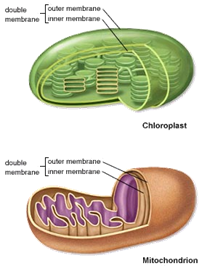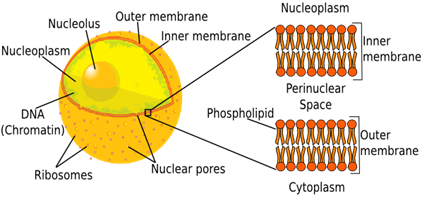Cell Membrane
Remember
that all cells, no matter what type, have a Cell Membrane (also known as
Plasma Membrane). You should also recall that the cell membrane surrounds
the cell, and serves to protect the cell and control the movement of substances
and messages in and out of the cell. We mentioned the idea of homeostasis as the ability of an organism to maintain a constant internal
environment regardless of changes in the organism’s external environment. Keep in mind that cells, at the cellular
level of organization, must also maintain homeostasis in order to survive. The cell membrane, controlling what
substances enter and leave a cell, is one way cells maintain homeostasis. We will
discuss in this unit the structural components of the cell membrane.
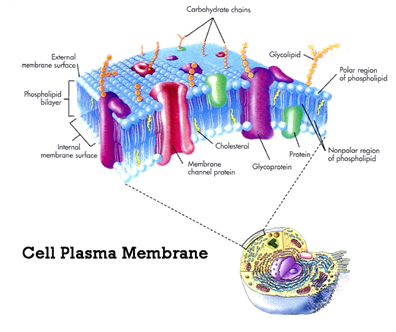
Phospholipid
Bilayer
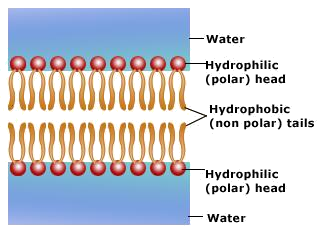
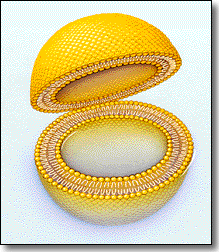 The cell membrane is made up of two layers of phospholipid molecules. A
phospholipid molecule is a specialized lipid molecule made up of a phosphate
and two fatty acid chains. The phosphate is considered the head and is
polar. The two fatty acid chains are
considered the tails and are nonpolar. The polar phospholipid head is described
as being hydrophilic, which means it is attracted to water. The nonpolar tails are described as being
hydrophobic, which means they are repelled by water. As you can see, in the
figure, the hydrophobic tails make up the interior of the bilayer (2 layer)
membrane. Since these tails repel water,
they make a good barrier for separating the water of the cytosol in the
cytoplasm found inside the cell from the water in the extracellular fluid
outside the cell. Because of the nature of this cell membrane, only certain
materials can pass directly through the lipid bilayer. Only small, nonpolar
substances can pass directly through the phospholipid bilayer. Other
substances that need to pass through the phospholipid bilayer for maintaining
homeostasis will make use of membrane proteins.
The cell membrane is made up of two layers of phospholipid molecules. A
phospholipid molecule is a specialized lipid molecule made up of a phosphate
and two fatty acid chains. The phosphate is considered the head and is
polar. The two fatty acid chains are
considered the tails and are nonpolar. The polar phospholipid head is described
as being hydrophilic, which means it is attracted to water. The nonpolar tails are described as being
hydrophobic, which means they are repelled by water. As you can see, in the
figure, the hydrophobic tails make up the interior of the bilayer (2 layer)
membrane. Since these tails repel water,
they make a good barrier for separating the water of the cytosol in the
cytoplasm found inside the cell from the water in the extracellular fluid
outside the cell. Because of the nature of this cell membrane, only certain
materials can pass directly through the lipid bilayer. Only small, nonpolar
substances can pass directly through the phospholipid bilayer. Other
substances that need to pass through the phospholipid bilayer for maintaining
homeostasis will make use of membrane proteins.
Cholesterol
is another lipid found mostly in animal cell membranes and in small amounts in
plant cell membranes. The cholesterol is
found dispersed among the phospholipids. The role of cholesterol is to keep the
cell membrane flexible so it doesn’t become too rigid. The figure at the
beginning of this unit shows cholesterol among the phospholipids in the
membrane.
Membrane
Proteins
There are
many different types of proteins found in the cell membrane. Some of these proteins face inside the cell,
some face outside, and others stretch across the phospholipid bilayer and face
inside and outside. These proteins are held in the membrane because of their
chemical nature. Remember that the
building block of a protein is an amino acid.
Some amino acids are polar while others are nonpolar. Nonpolar amino acids of a protein are
attracted to the nonpolar inside of the phospholipid bilayer while being
repelled by water. The polar amino acids
of a protein are attracted to water. This opposing chemical attraction with
water help hold the protein within the cell membrane.
There are four main types of
membrane proteins based on function: cell-surface markers, receptor proteins,
transport proteins, and enzymes.
·
Cell-Surface
Markers help
identify a cell type thus allowing one cell to distinguish itself from another.
These markers consist of a chain of sugars attached to a protein found in the
membrane. Recall that sugars are carbohydrates and sometimes use the prefix
glyco- in reference to glucose, therefore, since these sugars on a cell-surface
marker are attached to a protein they are then called glycoproteins.
·
Receptor
Proteins enable a
cell to sense its surroundings by binding to certain substances outside the
cell. “Receiving”, or binding to, substances outside the cell will cause
changes inside the cell as the receptor protein will relay the signals or
messages.
·
Transport
Proteins aid in
the movement of certain substances across or through the cell membrane. As mentioned earlier, only small nonpolar
substances can pass directly through the phospholipid bilayer of the cell
membrane. Transport proteins will help ions, most polar molecules, and other
substances that cannot directly pass through to be carried or “transported”
across the cell membrane. There are two groups of transport proteins: channels
and carriers. Channel proteins may be
permanently open (known as pores) or open and close (known as gated channels). Carrier proteins bind to a substance on
one side of the membrane and then carry that substance to the other side.
·
Enzymes are proteins in the cell membrane
that help with biochemical reactions inside the cell. Recall that enzymes are
proteins used to increase the speed of biochemical reactions within the cell by
lowering the activation energy of the reaction.
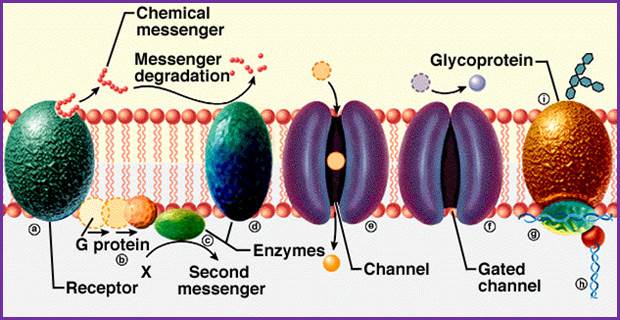
Fluid
Mosaic Model
The fluid
mosaic model is used to describe the nature of a cell membrane. The fluid
mosaic model was developed by S.J. Singer and Garth Nicolson in 1972 to
describe the structure of a biological membrane. The phospholipid component of the
plasma membrane is described as “fluid” because the phospholipids have the
ability to move laterally, or sideways, throughout the entire membrane within
their layer. “Mosaic” refers to all of the possible proteins, previously
identified, which can be found scattered and also moving with the phospholipids
throughout the phospholipid bilayer.
![]() Transport across Membranes-Fluid Mosaic Model
Transport across Membranes-Fluid Mosaic Model
Plasma
Membrane Differences
|
|
UNIT VOCABULARY
REVIEW
Click on the Quizlet icon below to access the quizlet.com vocabulary flash
cards. Review the vocabulary before completing your assessment.
 Now answer questions 1 through 20.
Now answer questions 1 through 20.
